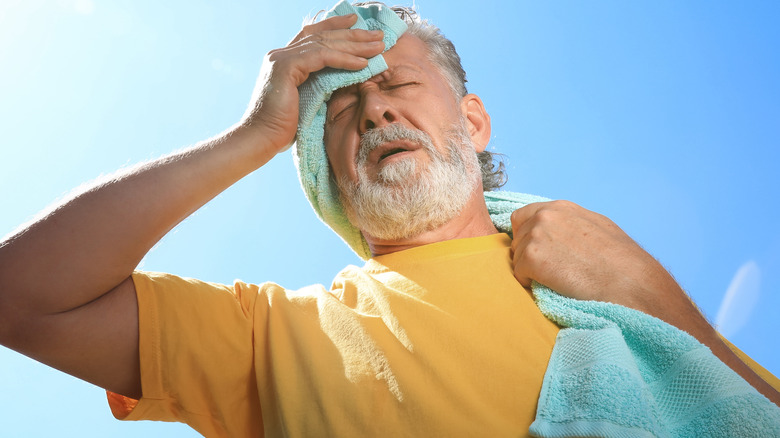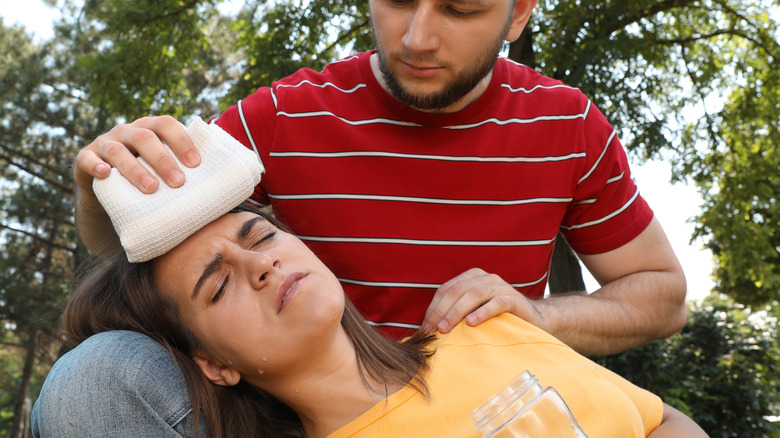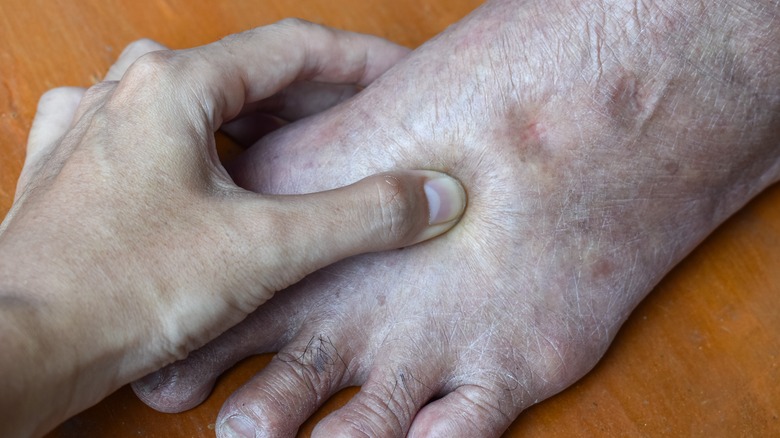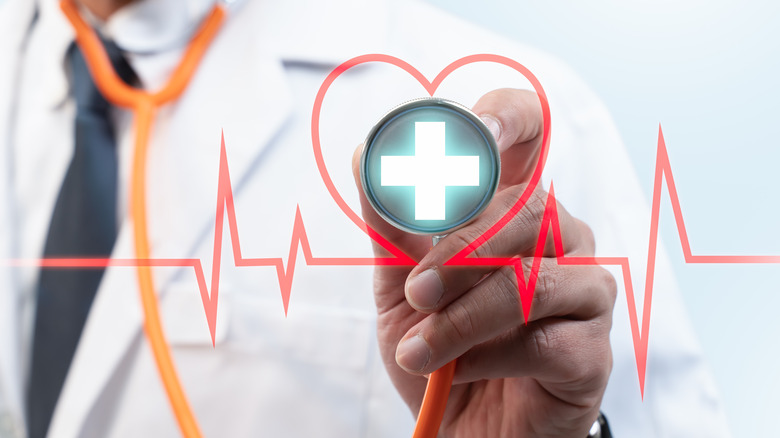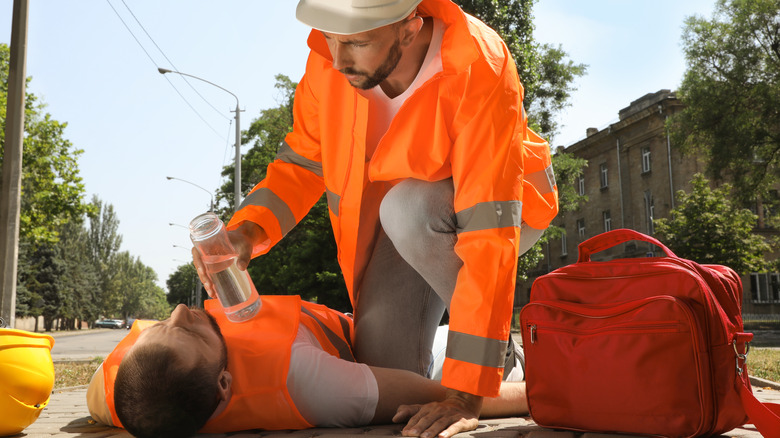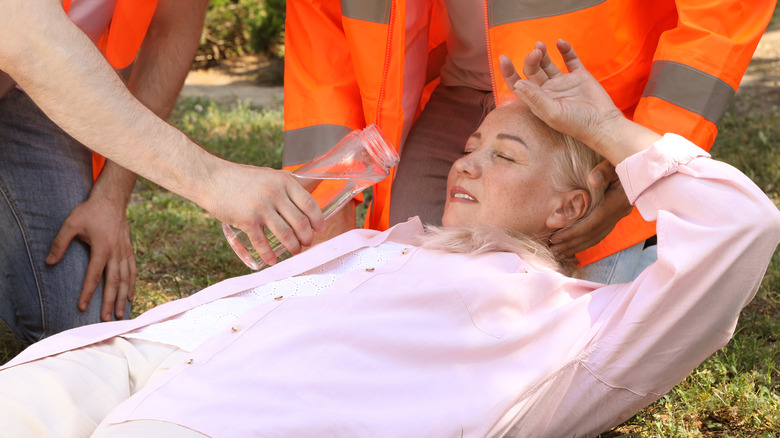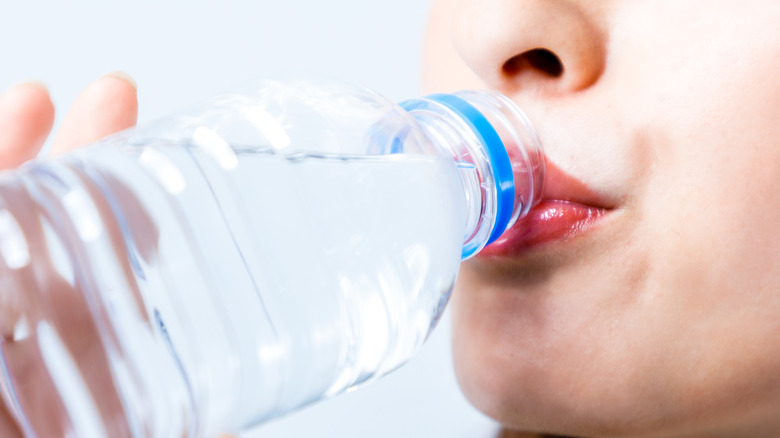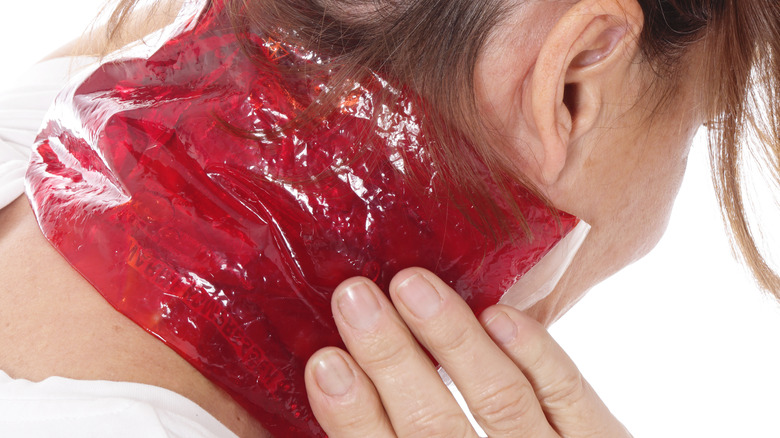How Heat Stroke Affects Your Body
A heat stroke (or heatstroke) is a severe condition where your body temperature skyrockets to dangerous levels, and if left untreated, it can lead to brain damage and even death. Imagine your body's internal thermostat malfunctioning in the scorching heat, unable to cool down despite heavy sweating. The average body temperature is around 98.6 degrees Fahrenheit, but heat stroke can cause the temperature to rise to 104 degrees Fahrenheit or higher (via Mayo Clinic). At these temperatures, the body's internal systems fail, increasing the risk of serious complications such as organ damage, seizures, and even death.
The symptoms can come quickly, from headaches and dizziness to nausea, confusion, and unconsciousness. It's a medical emergency that should not be taken lightly, primarily affecting older adults, children, and those with chronic medical conditions. But don't let this scare you: Taking simple precautions such as staying indoors during extreme heat, staying hydrated, and taking breaks can go a long way in preventing a heat stroke (per the Centers for Disease Control and Prevention).
Therefore, it is essential to understand what happens to your body when you have a heat stroke and how to be safe while in the heat.
Hyperthermia strikes when your body temperature soars
Are you feeling the heat? Keep an eye out for hyperthermia, the primary condition your body experiences during a heat stroke. Healthdirect states that hyperthermia occurs when your body temperature rises to dangerous levels, potentially leading to heat stroke. When your body is overheated, cooling mechanisms, such as sweating and vasoconstriction, kick in to help cool the body. However, heat stroke is imminent when these mechanisms cannot keep up.
Prolonged sun exposure, strenuous exercise, certain medications, and underlying health issues can all contribute to this scorching condition. Internal body temperature above 104 degrees Fahrenheit can cause serious health problems — including death — if the body cannot dissipate the heat (via National Institutes of Health). Stay in a cool place, hydrate, and avoid strenuous activity during the hottest parts of the day to avoid becoming overheated. If you suspect you are suffering from hyperthermia, seek medical attention immediately. Don't let the heat kill you; stay cool and stay safe.
The dangerous effects of heat stroke on the brain
The brain (specifically, the hypothalamus) regulates body temperature, and is one of the first organs to be affected when the body becomes overheated (via InformedHealth.org). High temperatures can damage brain cells as proteins emerge during extreme heat and kill cells. Some cells are more vulnerable than others, influencing which brain areas are damaged. One of the first areas of the brain to fail is the cerebellum, which controls motor function (and is the primary reason people suffering from heat stroke lose muscle control and start to stumble or collapse), per Brain Facts.
According to the National Institutes of Health, heatstroke is considered a medical emergency because it can have long-term consequences if action is not taken quickly to cool the body. Furthermore, high temperatures can dehydrate the brain, impairing its ability to function correctly. As a result, the person may struggle to think, speak coherently, or remember things (via Mayo Clinic).
Additionally, dehydration during a heatstroke can trigger seizures (per Epsy). High temperatures can cause this activity to become more intense, especially in people with a history of seizure activity. Heat-induced seizure activity can be hazardous, and may even cause permanent brain damage.
Because the brain is susceptible to heat, central nervous system impairment is imminent during a heat stroke. When this occurs, the person will display symptoms such as confusion, disorientation, hallucinations, and severe coma (via Medicine).
Your body's cooling mechanism may fail
When the body's cooling system is overworked during an episode of heat stroke, it can lead to a dangerous increase in body temperature. Sweating is one of the body's cooling strategies during heat periods. However, the body's cooling process will fail if a person spends too much time in the heat without drinking enough fluids. When the body becomes dehydrated, it can no longer cool itself through sweating. Therefore, when you sweat excessively without replacing the fluids and electrolytes you are losing, the body will overheat, leading to heat stroke (via John Hopkins Medicine).
For this reason, prevention is essential. In an interview with Baptist Health, primary care physician Dr. Solti-Grasz explains that prevention is critical when it comes to heat stroke. Once heat stroke occurs, the body's attempts to lower its internal temperature have failed and, at this point, is "systematically shutting down organs to protect the heart and brain."
Are you at risk for rhabdomyolysis?
Rhabdomyolysis is a life-threatening condition that occurs when your muscles break down or rupture and release their cells into your bloodstream. A study published in the Hindawi Journal states that the most common causes of rhabdomyolysis are strenuous exercise and heat stroke. Strenuous exercise can lead to overworked and strained muscles, a condition often seen in marathon runners. The severity of rhabdomyolysis can range from no symptoms to life-threatening conditions that can impact several organs.
Common symptoms of rhabdomyolysis include muscle pain and weakness. However, as it progresses, you may develop dark urine, a warning sign that your kidneys may be impacted. If left untreated, rhabdomyolysis can lead to kidney failure. In addition, heart arrhythmias can occur, increasing your risk for more complications (via CDC).
Taking precautions to prevent rhabdomyolysis when exercising in hot weather is essential. This includes staying hydrated, taking frequent breaks, discussing medications that could increase your risk, and wearing appropriate clothing. If symptoms of rhabdomyolysis or heat stroke are present, it is crucial to seek medical attention immediately (via Cleveland Clinic).
Prolonged heat exposure and heat stroke can lead to lower extremity swelling
The circulatory system is one of the most common areas affected by heat exposure and heat stroke. The body's temperature rises rapidly during heat stroke, causing the blood vessels to dilate to release heat (via HealthJade). This causes an increase in blood flow to the skin's surface. As a result, heat edema, also known as heat swelling, is one of the conditions that occur due to the impact on the circulatory system.
As fluid leaks from blood vessels into the surrounding tissue, fluid accumulates in tissues resulting in swelling, particularly in the legs and feet. In addition, if the loss of salt is less than what usually occurs in the body, the increased amount that lingers in the body works against it to pull fluid into the tissue, causing even more swelling.
Heat edema usually resolves after exposure to the heat source is removed. However, ICliniq mentions that if you have certain medical conditions such as diabetes, heart failure, pregnancy, or are not accustomed to being in the heat, you may be at an increased risk of developing edema.
Heat syncope
Heat syncope is a type of fainting caused by prolonged exposure to high temperatures or exertion in hot weather when your body is not acclimated or hydrated (via CDC). Initially characterized by dizziness, lightheadedness, and (if untreated) fainting, it is frequently caused by the body's efforts to cool itself by sweating, which can result in fluid and electrolyte loss and, as a result, dehydration, low blood pressure, and decreased blood flow to the brain (per the University of Connecticut).
Additionally, certain circumstances may increase the likelihood of developing heat syncope. Dizziness or fainting may occur after prolonged standing or a sudden change from lying to standing. Furthermore, certain occupations (e.g., firefighter, military personnel, or anyone required to wear additional equipment in hot weather) are at increased risk of heat syncope.
The University of Connecticut suggests some ways to avoid heat syncope, such as staying hydrated and replenishing fluids while in the heat. Alcoholic beverages should also be avoided because they can dehydrate you. Furthermore, if the syncope is caused by overheating during exercise, consider moving the workout indoors or scheduling it at a cooler time of day.
Understanding the impact of heat stroke on heart health
Heat stroke can be dangerous for your heart as it forces it to work harder. This can lead to an increased heart rate, high blood pressure, and even strain on the heart muscle. In severe cases, it can cause cardiac arrhythmias, heart attacks, and even death.
A study published in The Journal of the Saudi Heart Association found that heat stroke patients often experience abnormalities in their electrocardiograms (EKGs), such as a fast heart rate (tachycardia) and changes in blood flow to the heart. However, Cooper Heart Institute notes that it's important to remember that these changes are a natural response to a high body temperature.
If you have any pre-existing heart conditions, it's crucial to talk to your healthcare provider before engaging in any strenuous activity in hot weather. They can advise you on how to adapt to the heat and take necessary precautions to protect your heart.
Complications can happen if left untreated
Heat stroke can cause serious complications if it goes untreated, both in the short and long term. Although these complications are rare, it's important to be aware of the potential dangers to protect yourself. According to the Cleveland Clinic, heat stroke makes the heart work harder, leading to strain on the heart muscle and reduced blood flow to the heart, which can cause circulatory problems. In addition, acute respiratory distress syndrome, a serious condition that requires intensive care, can occur due to heat stroke.
Heat stroke can also cause damage to the brain, kidneys, and liver by damaging muscle tissue and causing swelling in the organs. Left untreated, it can cause permanent damage due to swelling (via Magid).
It's important to note that these complications occur in severe cases of heat stroke, and not all people who experience heat stroke will develop these complications. However, it's important to seek medical attention immediately if someone is suspected of having a heat stroke to minimize the risk of complications.
Are you at high risk for developing heat stroke?
Certain groups are at a higher risk of developing heat stroke than others. According to the Cleveland Clinic, heat stroke occurs annually in approximately 20 out of 100,000 individuals in the United States, and there are up to 833 deaths caused by heat stroke annually. Elderly individuals are at a higher risk of developing heat stroke due to age-related changes in the body that make it harder for the body to regulate its temperature. They are also more likely to have chronic medical conditions that can make them more susceptible to heat stroke.
In addition, children are more susceptible to heat stroke than adults because their bodies are still developing (per CDC). They have a higher surface area to body mass ratio, making it harder for them to dissipate heat. Furthermore, children have less fluid in their bodies, making them more prone to dehydration.
According to Health Partners, athletes and manual workers exposed to high temperatures for extended periods are at a higher risk of developing heat stroke. This is because intense physical activity can raise the body's temperature and make it harder for it to dissipate heat.
Furthermore, some medications can make the body more susceptible to heat strokes, such as diuretics, antidepressants, and antipsychotics (via Health Partners). Individuals who take these medications should be extra cautious. It is essential to discuss any medications with your healthcare provider to ensure they do not increase your risk of heat stroke.
Tips for preventing heat stroke
Keeping your body temperature and hydration levels in check to avoid heat stroke is crucial. Seek out air-conditioned spaces during hot weather, and drink plenty of water and fluids that contain electrolytes. Additionally, try to avoid strenuous activity during the hottest parts of the day. It may be possible to exercise or work if it is not too taxing on the body but listen to your body's cues to prevent overheating (per Health Partners).
The way you dress is essential, as tight-fitting clothes can cause overheating. Therefore, dress smartly in loose, lightweight clothing and a wide-brimmed hat, and be sure to protect your skin with high-SPF sunscreen with a minimum of 15 SPF (via CDC).
If you're going to be outside for an extended period, take frequent breaks in the shade or an air-conditioned space. High-risk groups like older adults, children, athletes, manual workers, people with chronic medical conditions, and those taking certain medications should take extra precautions to keep cool and safe.
Steps to take in the event of suspected heat stroke
If someone is suspected of having a heat stroke, it is essential to take immediate action to lower their body temperature and seek medical help (via Health Partners). To do this, move the person to a cool, shaded area or an air-conditioned space. Then, remove any excess clothing to help the body cool down.
Next, place cool, damp cloths on the person's skin or use a water hose to cool them. If available, use a fan or ice packs. Place ice packs in the armpits, groin, and around the neck for the best effect. If possible, monitor the person's vital signs, such as heart rate, breathing, and temperature. Give the person ice chips, water, or an electrolyte drink like Gatorade if they are conscious and able to swallow.
Remember that cooling the person down is the first priority, but if their condition worsens or they cannot drink fluids, call emergency services immediately. Heat stroke is a medical emergency that requires prompt treatment to avoid serious complications (via Mayo Clinic).

